Ric & Seth Estrada

You’ve illustrated books and comic books. What else have you done?
Ric: I’ve done books, comic books, and television commercials. I’ve done advertising, illustrations, and storyboards for film and for TV commercials. And I’ve also directed and co-produced in animation. I have written as well. The last thing I did for Feature Films for Families was a TV series that consisted of twenty-four half-hour episodes which I wrote and storyboarded, called The Princess and the Pea Chronicles. They were never produced, though. The show was based on a feature that was being directed, but the feature didn’t go too far, so they said, “Why should we have a sequel with a TV series?” and they canceled it. When you do any kind of work, you pretty much depend on your editors and directors—all the people at the top.
When you worked for Hanna-Barbera, did you storyboard or animate?
Ric: I did not animate—I’m not an animator. They used hand animation, and I storyboarded and did character design as well. There’s a full-length feature they did about The Jetsons that I storyboarded and co-art directed with another person.
What characters did you design that we all would recognize?
Ric: Well, I didn’t necessarily design these characters, but I was assigned to make a comic book about them for DC Comics. You would recognize Superman, Batman, Wonder Woman, the Legion of Superheros, and there was one that not many people seem to know, outside of the collectors: Gallery of War. Those were war stories about the heroics, the miseries, and the horrors of war. They were six-page stories with really interesting plots written by Robert Kanigher, who was one of the top writers at DC Comics and was actually one of the editors of Wonder Woman for years. He could write anything. He would go to a convention and say “Throw me a theme” to the audience, and the audience would say, “What about this and that?”, to which he would reply, “Okay, let me tell you a story.” He would then tell a story based on some idea that a person threw him. He was very good.
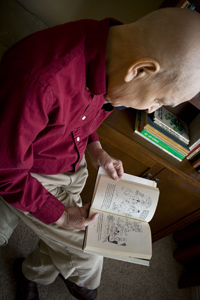
Which specific wars were the Gallery of War comics about?
Ric: Oh, all wars—World War I, World War II, etc. I had one on the Boer War in South Africa, and at one time my editors said, “We have a six-page opening, but we don’t have a script or anything. Write us a war story and illustrate it.” I asked, “Can it be any kind of war?” and he told me it could be any kind of historical war, anything I wanted. So I said, “I’ll give you a story from the Book of Mormon,” and I wrote a story called “Peace with Honor,” which was about the book of Ether and the two parties that exterminate each other, and it was published.
This all then led to a phone call I received about a year later from Elder Hugh Pinnock, one of the members of the Seventy, who said, “One of the local missionaries picked up this comic book and showed it to me, and we have the whole “Old Testament for Children” that needs to be illustrated. I have looked at your background; you are a member of the Church in good standing, and we would like you to illustrate it.” He came from Salt Lake on his way to New York to interview me. We talked about it, he gave me a script, and I began to illustrate it. You may have seen that book. It’s not the current edition, though; it’s the first edition.
Did you do anything else commissioned by the Church, or was that your only project?
Ric: That was the one project, and it took six months. My real delight in it, though, was not only the subject, which was wonderful, but what happened because of it. At first when they offered me a certain amount of money and I counted the number of pictures that went into the book, I thought, “There’s no way I spend six months of my life doing this for that amount of money.” So I wrote a little note and proposed that we count the pictures together and work it out. There were three different sizes, and I offered various prices for them before we took a look at the bottom line. Lo and behold, it ended up being twice as much as what they were offering. They thought about it for a few days and they accepted it. Later the art director of the Church telephoned me and said, “Thank you, Ric, because the Church, not knowing the worth of art, has been underpaying its artists miserably, and you have pushed the envelope to a very decent level.” That was my greatest victory.
According to Sal Velluto, who is a good friend of mine and does a feature for the Friend magazine about the lives of the presidents of the Church, they pay very decently today. He said it was thanks to me, and that was nice.
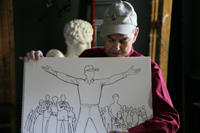
Didn’t you also work on a Bible project for Hanna-Barbera?
Ric: Yes. I did one for Hanna-Barbera, and my producer at the time was Kay Wright, who is a member of the Church. We considered doing something called The Greatest Adventures. We had thirteen episodes of the Old and the New Testament. We also had somebody writing the series who was a scriptwriter for The Love Boat, and he had never read the Bible. But he did read the Bible just for that project. We had a character named Mokee, who was kind of a funny character. He was one of the narrators of the story. The basis of it was that these two American kids, a boy and a girl, meet this character named Mokee, who is a Middle Eastern boy and a clown. Somehow they fall into a cave, and there is a door that they knock on which takes them into the past. In each episode they are in one part of the Old Testament or the New Testament. That was the story. But Mokee spends the whole time cracking jokes and saying totally crazy things. And we couldn’t have that. So we did thirteen episodes. I was the co-producer of that show, and the storyboard man.
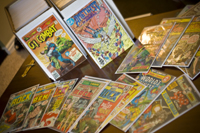
Were you specially picked out for that or did you ask to be on it?
Ric: I think because they picked us out for it because they knew that Kay, my co-producer, and I were religious. Besides, many of the storyboards at that time at Hanna-Barbera were given to me because I’d had more experience than any person on staff. I had vast experience. I learned to do storyboards in three years when I lived in West Berlin during the Cold War. I went there to write a movie with a friend, and we tried to sell it in England, but nobody bought it. Later in America, United Artists said, “We want it! We want it!” But then, as often happens in the movie industry, for every movie you see on the screen, there are maybe fifty others that never got anywhere. It went up the rungs to the president of United Artists, and he ended up saying, “No, we’re not going to do this.” We both were full of hope, and I ended up being stranded in Berlin.
My good friend from Chicago, McKinley Olson, sent me to work for the newspapers there, and I stayed for three years. I was hired by one paper called the Spandauer Volksblatt, and I started doing political cartoons for them, which was my morning job. At the same time, I was working for a movie company, Deutschen Documentar, and it was a company that filmed mostly commercials. While I was there, I learned to do storyboards directly with movie directors and with writers. I was also taught the secrets of camerawork and angles—up, down, left, right, close-up, middle shots, long shots, etc. I learned a lot from their coaching.
When I came back to America, I worked in New York for many years at DC Comics. Then my wife and I moved to California and there I began to work for Hanna-Barbera, DreamWorks, Warner Brothers, and Universal. Essentially every studio except for Disney. For some reason Disney and I never clicked.
You sound almost proud of that.
Ric: Well, yes, because I had a friend that worked for Disney. There was a department there called Imagery and they were creating avant-garde ideas, and he said, “You belong there.” I applied, but it’s always a question of timing. And if that’s not the right place or the right moment, they don’t hire you.
But there was a time when I was between studios, for about three months, and I was called by a group who had some work on a two-part series called Spawn, a superhero type. They interviewed me and loved my work. When they told me that I was hired and that they wanted me to direct and storyboard the series, I said to them, “Well, tell me something about it, because I don’t know anything about Spawn.” They showed me something from it and said, “It’s adult.” I asked, “What do you mean, ‘adult’? You know, I have a family, and I’m raising eight children.” They said, “Well, it has a lot of sex.” It became the first time in my life that I rejected something I was offered. The money was good, and it had a lot of prestige, but I told them, “While I raise my family, I couldn’t face my children if I had to direct something full of a lot of sex and violence. So, sorry, thank you very much, and goodbye.” One of the co-producers ended up saying to me, “You know something, this stuff is so strong that sometimes when I visit my mother, I feel very insecure telling her that I am co-producing this thing.” And that’s how I feel. About two weeks later Hanna-Barbera rehired me to do something called Captain Planet, which was a wonderful series and one of the most satisfying ones I ever did. I storyboarded it and designed some of the characters.
There’s a funny story attached to that. We had a staff that got along so well together. They took us and put us into this trailer, our own little studio. We were like a little close-knit family. There was the producer/director, the storyboard man (myself), the character designer, the background designer, the sort of coordinator of everything, and the writer, who knew nothing about animation. He was an adventurer and a nice young man, and he wrote the plots. I don’t know if you are familiar with Captain Planet, but it’s about these four kids who with a magic word become Captain Planet. They were a black girl, an Asian girl, and a white boy and girl, so it was kind of ethnically PC. I designed the main character, Captain Planet, but the writer never liked anything we designed. We gave him five or six or seven versions of Captain Planet, and he always said, “Oh, no, that’s not it. No, that’s not it.” So one day I had the devilish idea to sit down and draw him. Later when we sat him down to look at it, he said, “That’s it! I don’t know why, but I like it! I like it!” He didn’t even recognize himself. And that’s the one we used.
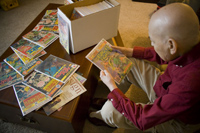
How did you find your way to Utah?
Ric: I was not a member of the Church when I was in Germany. I had one of the darkest days of my life when I was working for the newspaper. I went to Africa to do a report on North Africa with cartoons and writing. I took an extra week there, but the editor-in-chief wanted to bring me back a week earlier. When I finally returned I said, “Look at all the material I wrote,” and he just told me, “That’s nice, but you’re fired.” And I said “Fired? But look at what I brought back.” And he said, “We have to set an example. We live by the book here, and if you take an extra week off…” I interjected, “But it wasn’t a vacation—I was working!” “Too bad,” he told me. “You’re fired. Here in Germany we have a tradition where whoever leaves a company caters a party for those who stay.” So the next day I went out and bought a food-and-drink spread, and we all ate and got royally drunk. I was so bitter that I went up to the editor and slapped his face. I felt so bad about it that I went back to my room and, in tears, got on my knees and said, “Lord, I’ve become so lost. I’m a monster. I was raised to be a good person. How could I do a thing like that? I am lost, Lord. Find me.” And you won’t believe this, but the next day, two Mormon missionaries knocked on my door. He found me. And that was the beginning of my conversion.
I spent three years reading the Book of Mormon, the Doctrine and Covenants, and whatever other literature I could find. I didn’t believe I was ready because I felt so stupid. When they set a baptismal date for me, I said, “I’m not ready.” But when I came back to America, another miracle happened to me. One night I went to a used bookstore in New York, and I picked up this book called The Devil Drives, which is the story of Richard Burton, an English explorer who discovered the Blue Nile. I opened it to the page where he was in Salt Lake City, where he met Brigham Young and interviewed him. I saw it and thought, “This is it.” I then went back to my room and telephoned the mission home. I said, “Three years ago I was taught by your missionaries in Berlin, and I spent the last three years reading all about the Church, and now I’m ready.”
So the next day they sent the missionaries over, and three weeks later I was baptized into the Church in New York City. Two days after that I met my wife, Loretta. She was a convert too, of one year, and six months later we were married. We have been married now for thirty-eight years and have eight children—Seth is one of them—and that’s the story of my conversion. It was like a new life for me. A new life completely.
Did your conversion change your art in any way?
Ric: Not really. My art was never rowdy or anything like that. About one-third of my books were illustrated before I joined the Church, and most of my comic books were illustrated after I joined the Church. It didn’t really change my art, but it changed my thinking, and at that time I was trying to convert all of New York City. As a new convert I lost a lot of friends. I was insufferable, talking about the Church all the time. But you know, the friends that stayed with me were the good ones. They didn’t join the Church, but at least they were my real friends.
My conversion did lead me to writing that story about the book of Ether, as well as my illustrations for the New Testament Stories for Children. It also led me to the thirteen episodes of The Greatest Adventures Ever Told at Hanna-Barbera. I don’t think I could have done those before I joined the Church. I didn’t have the insight that I gained from becoming a member. So in that sense it changed—if not my style, then my viewpoint. And that’s a major change.
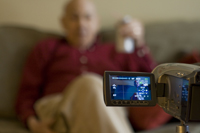
Seth, how did you first get the idea to make a documentary about your dad?
Seth: From Kelly Loosli. He’s on the faculty at BYU and heads up the animation program there. He had worked with my father at DreamWorks and had, over the course of several months, gone over a lot of my dad’s experiences and stories and really gotten to know him. He said to himself, “Wow, this guy is kind of unreal. He’s almost like the Cuban Forrest Gump. He’s been everywhere and done everything. This would make a really good documentary.”
My brother Jeremy got into the animation program and introduced me to Kelly, and what most people don’t know about Kelly is that, prior to going into animation, he got his degree in documentary filmmaking. So he told us that we should help him make a documentary about our dad. He also said that as faculty he might be able to qualify us for some good funding to get it made. Of course, at that time, Jeremy and I were both full speed ahead with our college careers, and we didn’t get the proposal submitted on time, so we lost out on about twenty or twenty-four thousand dollars’ worth of budget.
The seed was planted, though, and the following year, I thought, “You know what? I really do want to make this documentary about my dad.” It wasn’t what I was studying, and it wasn’t ultimately what I really want to do, or what I wanted to do at the time (which was feature filmmaking), but I love my dad. His story is so important to me because it has really helped shape the culture of my family. The stories that I share with my siblings are highly informed by my father’s story, and I want to pay respect to him by telling it.
As you’ve been putting this documentary together, what obstacles have you been facing?
Seth: Right now we’re approaching year four of production on this documentary, and I think with any project of this nature, once you get past a certain point in production, which is usually after all the base footage from which you want to cut a documentary is collected, the issue of momentum comes up. Time, money, and inspiration also come up. With the time, you have to make it, and with the money, you have to find it. Inspiration tends to come as you look for the other two. We’ve had the logistical issues of having a core creative team disband, and then realizing, “Okay, I’m on my own right now, and that’s okay. I’ll just re-form that core creative team and then we’ll move ahead.” That’s about where we are now.
You said you’ve had a little bit of budget. Where does that come from?
Seth: That came from a grant I applied for while I was a student at BYU. The conditions didn’t require the project to be finished, though. We gave them status reports and let them know to what point we had finished. Since then we haven’t received any more funds, but we’ve gotten a lot of momentum, certainly. It’s been surprising how many doors have opened. We actually recently interviewed the president of DC Comics, Paul Levitz, which was a really great blessing.

In regards to making time, it sounds like there was a period where you couldn’t. What changed?
Seth: The thing that made it hard to continue with the documentary was being jobless for a couple months. Being out of work in Southern California with a wife and two kids to feed is no laughing matter. Obviously, those were dire circumstances that required immediate action. It was kind of a sucker punch, really, because we were set up with these expectations that we would be able to get a job, no problem. You finish up an internship at a major studio, and the anticipation is that—provided you haven’t upset anyone who sits at a big desk—you’ll have a job. And that didn’t happen. We then went knocking on the doors of all the other studios, then all the smaller studios, then the even smaller studios, and after a couple of months it got a little worrisome. So, I found a day job, and that’s fine.
Since you are making a documentary about someone you love, whose image and representation you care about deeply, does that ever make it hard to tell the story well?
Seth: Absolutely. Objectivity is lost. Objectivity is always in question whenever you are making any sort of art, because it’s obviously a construct, and when you’re close to the subject, you are subjective instead. Having that storytelling voice from the perspective of the son talking about his father, there’s already a fine line, and even with a great deal of the father’s help, it’s going to be painted with the son’s brush strokes. I have great charity for my father, because I love him, and it’s really hard to be objective and look at him as a character. But at the end of the day, viewing him as a character ultimately wins out.
I think that one of the things that I struggle with, as far as knowing how to represent my dad, is that he has a very unique sense of humor that was experienced by my siblings and myself when we were younger. We can’t experience it the same way, though, because we aren’t the same age anymore. But it was so real, and so tangible, and so thoroughly enjoyable. If I could share my story, that’s one of the parts of it I would want to show. I ask myself quite frequently, “How do I show that? How do I share that? How does that become real for somebody else?” And then hopefully it leads to a moment of truth for them, where they think, “Oh wow, I feel something, and I see something in myself. That resonates with me.” That’s one of the biggest aspects of this project that I struggle with.
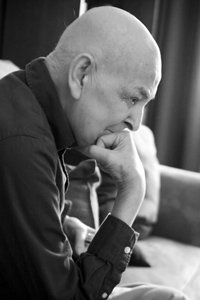
Has working on this piece affected your relationship with your father?
Seth: Having this time to spend with my father, and having a reason to spend this much time around him is certainly improving our relationship. It is giving us time together that we wouldn’t otherwise have. Our relationship has always been healthy, though, and very loving. These are the fruits of it that are quite mature.
What keeps you going to work on this documentary?
Seth: It’s the same thing that keeps me going to work every day: prayer, scripture study, and a rose-colored, titanium-built woman. My wife is awesome, and she is my “go-to gal” right now. She’s the person that helps me get my head on straight, and when the world is bleak, gives me the big picture—she provides a little color correction, helping me see things as they are again. She winds me back up and sets me back in the right direction.
What are your most memorable experiences from working on this piece?
Seth: Because the production has been such a lengthy process, the most memorable experiences are the most recent ones. It’s almost like the mission—it’s the best two years of your life, until you get home and start living your life right, and then the next two years are the best years of your life, and so on and so forth. It should keep on building. The last interview, with Paul Levitz, president of DC Comics, was the most memorable interview before today. That was huge. But it pales in comparison, in my opinion, to this.
How do you hope this documentary will influence your career?
Seth: First and foremost, it has been a wonderful exercise in how to keep objectivity while working with a subject that is very, very close. Also, it’s been a great way to learn how to rebuild a team quickly. I’ve always been fairly quick on my feet when I’m on a small team, and moving with a large collaborative team has been more difficult. I am finding that to be a necessity. I absolutely have to interface frequently with a lot of people for this project to work. This one requires it a lot more than with other personal portrait documentaries because my dad has been around the block a couple of times: in comics and animation, and even just around the world. So this is going to be a little more than a one-man show. I’m hoping for growth there, and I’m also hoping for the opportunity to meet and collaborate with and have future dealings with like-minded individuals who don’t ask me to compromise my morals in order to make good art. Ultimately I am hoping to find distribution that is fruitful and multiplies.
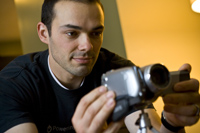
Do you see yourself making more documentaries in the future?
Seth: You know, I do. I really do. I started the documentary telling myself, “This is not at all what I want to do,” but I have freedom in this medium to relate the story however I want—I mean, I’m bound by some formulas and generic expectations to some extent, because if no one wants to watch it, it’s like it doesn’t exist. But I’m not as bound as I would be with other kinds of films.
I think every artist aspires to make something that stands the test of at least some amount of time. So if I can enjoy this film five seconds longer than the last one that I made, that’s a measure of success. If I can enjoy it for the rest of my life because I feel like there is some element in it that has watchability and the truth I strive for, then I’ve arrived. What more could I possibly want?
Do you want to be a one-man show for the rest of your life?
Seth: Certainly not. I enjoy video production. I’ve been involved with it for years now, on some level or another. Not just by myself, though. I have worked with other teams, and been a freelancer and a part of post-production. But so far, it’s giving me a better idea of what side of production I want to end up on, and how much and what type of pre-production I really enjoy most.
Do you have a vision yet of what the finished film will look like?
Seth: There are a lot of components that have been percolating, that haven’t yet all been laid out together. The psychology term is that I have been making tiny chunks. I am so used to the short form that short form components are there. I see the sequence, and I see the act, but I haven’t seen the whole thing appear yet. But there are sequences, acts, and certainly several scenes that I have already visualized.
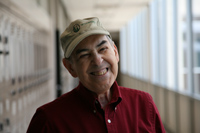
When this documentary is finished, do you think that you could call it “Mormon cinema”?
Seth: That’s really the million-dollar question, isn’t it? Going back to the purposes of art, and the purposes of filmmaking in general, can you push an agenda? Probably not. Can you reveal truth about yourself? Probably. I grew up Mormon. That’s part of my filmmaking voice. It’s always going to be a part of me, always.
Even if I wanted to create something that wasn’t for a Mormon market, or something that violated the LDS aesthetic in every way along with the covenants that I have made as an LDS person, I was born and raised in the covenant. My storytelling voice will always reflect that. That’s the blessing, you might say, the ties that bind us and pull us back, even as storytellers. So, yes, it’s Mormon cinema in that respect. Is it for a Mormon audience? Not exclusively. After all, the message of the gospel isn’t for an LDS audience exclusively. This is for open hearts and for good people everywhere.
How can our readers get involved in helping with the film?
Seth: One way is transcription. We have dozens of hours of interviews, and many hands make light work. It’s something that anyone can do. You can check out our website and sign up right there.
There’s a form that lists any number of other ways to help, whether it’s donating materials or graphic design, or animation, or character design. This documentary, by the way, isn’t just live action, but contains a considerable animated portion as well. If you have any skills there, we can use those skills. ❧
